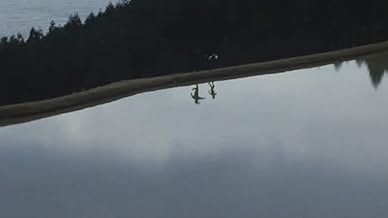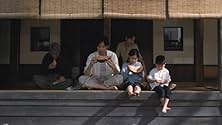El esposo de una joven aparentemente se suicida sin previo aviso ni razón, dejando atrás a su esposa e hijo.El esposo de una joven aparentemente se suicida sin previo aviso ni razón, dejando atrás a su esposa e hijo.El esposo de una joven aparentemente se suicida sin previo aviso ni razón, dejando atrás a su esposa e hijo.
- Dirección
- Guionistas
- Elenco
- Premios
- 9 premios ganados y 1 nominación en total
- Dirección
- Guionistas
- Todo el elenco y el equipo
- Producción, taquilla y más en IMDbPro
Opiniones destacadas
I don't think I have ever witnessed a film, in which the cinematography was so outstanding that it really was the star of the picture. This film, about a Japanese woman who remaries and moves to a small fishing village after her last husband comits suicide is less about the story but more about its surroundings. Scenes are mostly taken and shot from a distance with little camera movement, in a way they become living paintings. Blues, reds, and greens come in to accent shots, moving vehicles enter to give splash of colour and brilliant contrast. The actors are distant. I couldn't take my eyes let alone blink for the fear of missing something amazing. The simple act of a child throwing a pink ball, to the sunlit rooms that get illuminated, to blue paint in fishing boats it all had me engrossed. I found myself more as a participant in a museum gallery of high art than being engaged in a plot or story not that there isn't one or that it was bad. I have never witnessed a film like this and even found that just the scenes themselves and the background of story brought so much emotion out of me.
A remarkable piece of cinema
Rating 9 out of 10
A remarkable piece of cinema
Rating 9 out of 10
With a cinematic eye that harks back to Kurosawa and the first color features of Antonioni (esp. Red Desert & Blowup), Maborosi is one of the quietest and most delicate little films you will ever see. It is the absolute antidote to fare like Die Hard.
I was fortunate to see Maborosi on a large screen at the Joslyn Art Museum. The venue was appropriate, for this film stands as one of the great achievements of the cinema. Indeed, I will go out on a long limb and argue that it deserves comparison to Carl Theodor Dreyer's Passion of St. Joan of Arc. Light, shadow, angle: in my experience these two films apply the most basic elements of cinematography in a most remarkable and brilliant fashion.
Maborosi opens with an astonishing shot, as the viewer looks up from one end of an arching bridge to see a young child following an old woman. The shot is meticulously framed by light posts, giving the impression of a picture on canvas. The camera remains still while the two actors proceed through the scene. The director's brilliant eye for placing everything "just right" immediately catches one's attention. It is a virtuoso shot; and then one's amazement grows as scene after scene continues with no drop off in the careful, artful composition of each image. After awhile, the viewer may become conscious of the camera: it does not move. As each scene commences, the activity occurs within a new, steady frame. I think that the camera moves during a scene only three times in the film, and then only in side-to-side pans. However, I was so enthralled with the film I may easily have overlooked some motion.
The story, concerning a young women's travail in overcoming the grief of her suicided husband, plays out quietly and slowly. The actors speak sparingly, and emotions are primarily portrayed through facial and bodily expression. The impact is large and plumbs depths. If a film like this were made in Hollywood--an utterly absurd idea--I'm sure the characters would be babbling on at each other. Maborosi explores the virtues of silence, patience, and careful attention: behaviors which are not widely cultivated in contemporary cinema, or in contemporary society for that matter.
Maborosi is a film to captivate those who want to see cinema which strives to be more than mere entertainment. It is in every sense an "art film," but in my mind it stands as one of those very rare films which emphasize the artful without a hint of the self-conscious and annoying artsy. A monumental achievement.
Maborosi opens with an astonishing shot, as the viewer looks up from one end of an arching bridge to see a young child following an old woman. The shot is meticulously framed by light posts, giving the impression of a picture on canvas. The camera remains still while the two actors proceed through the scene. The director's brilliant eye for placing everything "just right" immediately catches one's attention. It is a virtuoso shot; and then one's amazement grows as scene after scene continues with no drop off in the careful, artful composition of each image. After awhile, the viewer may become conscious of the camera: it does not move. As each scene commences, the activity occurs within a new, steady frame. I think that the camera moves during a scene only three times in the film, and then only in side-to-side pans. However, I was so enthralled with the film I may easily have overlooked some motion.
The story, concerning a young women's travail in overcoming the grief of her suicided husband, plays out quietly and slowly. The actors speak sparingly, and emotions are primarily portrayed through facial and bodily expression. The impact is large and plumbs depths. If a film like this were made in Hollywood--an utterly absurd idea--I'm sure the characters would be babbling on at each other. Maborosi explores the virtues of silence, patience, and careful attention: behaviors which are not widely cultivated in contemporary cinema, or in contemporary society for that matter.
Maborosi is a film to captivate those who want to see cinema which strives to be more than mere entertainment. It is in every sense an "art film," but in my mind it stands as one of those very rare films which emphasize the artful without a hint of the self-conscious and annoying artsy. A monumental achievement.
In 1998 the Japanese director Hirokazu Koreeda astonished those of us who feel passionately about the expressive power of cinema with "After Life" a film about the hereafter that I would claim to be one of the masterworks of the past decade. The effect of this was so mesmerising that for some time I completely forgot about "Maborosi" an earlier work that I had caught up with only a few days before. Although not in the same league, it is worth a look if only to trace the origins of the later piece. Just as "After Life is a meditation on life from the point of view of the dead, "Maborosi" reverses the process and meditates on death from the living's perspective. A young girl feels somehow responsible for the death of her grandmother whom she cannot persuade to return to the family home after she wanders off one day. As a young woman she again is unable to escape a feeling of guilt when her husband is unaccountably struck down and killed by a train. These events happen fairly quickly in the first third of the film. The rest is an elegiac account of her second marriage to a widower with a young daughter and their life together in a remote fishing community as far away from the cramped streets of the city as it is possible to imagine. With the baby son by her first husband now grown to a small boy the new family feels complete. And yet the woman still exists in a state of unease. Although there are no more disasters, there are continual reminders of the frailty of life. An elderly woman, not unlike her grandmother, takes a boat out in a storm but returns unharmed. On a later occasion she watches an anonymous funeral procession which seems held in longshot for an eternity. "Marobosi" which means "The Beckoning Light" - a clear reference to death - is full of the influences of other directors. There is that of Ozu in the many domestic interiors where the camera seldom moves, Angelopoulos in the many long held exterior vistas and even Hou Xiaoxian in the way the audience is made to concentrate hard to work out character reactions and situations given a minimum of verbal and visual information. One curious fact about the film is the way the characters either appear in shadow or middle distance so that their emotions are hard to recognise. In the end this effect of deliberately distancing the protagonists is the film's essential weakness. It gives a sense of detachment and uninvolvement that Koreeda was to overcome triumphantly in the marvellous "After Life".
Rarely do I rate films so highly, but Maborosi earned it's nine. A large part of my enjoyment of the film was due to the beautiful and subtle directing that seemed to compliment the story itself perfectly. Koreeda is a very promising Japanese director. I recommend this one to all serious movie watchers, and I await his future films.
¿Sabías que…?
- TriviaHirokazu Koreeda's directorial film debut.
Selecciones populares
Inicia sesión para calificar y agrega a la lista de videos para obtener recomendaciones personalizadas
- How long is Maborosi?Con tecnología de Alexa
Detalles
Taquilla
- Total a nivel mundial
- USD 144,025
Contribuir a esta página
Sugiere una edición o agrega el contenido que falta























